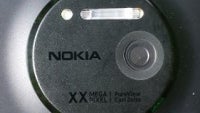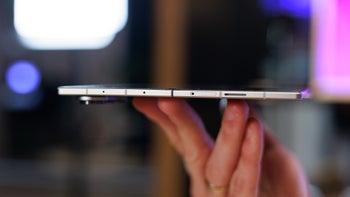Here is why Nokia EOS uses a mechanical shutter for the camera

The Nokia EOS has leaked out extensively last week and one peculiar feature in the camera superphone is its use of a mechanical shutter. Why is it there, though? Nokia’s former camera guru Damian Dinning is probably the best person to answer that question and his recent comment makes it all very clear - it’s because of xenon flash.
The rumored 41-megapixel camera on the Nokia EOS uses the more powerful xenon flash rather than the LED flash most other smartphones employ. But unlike LED, Xenon actually fires a very short light beam of the equivalent of shutter speeds as low as 1/25,000. In electronic shutters, though, pixels have to shut down all at the same time and this simply happens at a lower speed than the flash which would cause issues with the image - some pixels could just remain black.
Dinning’s full explanation is right below:
Hi everyone, there are so few factually correct statements in the original piece or related comments (no disrespect intended) I felt compelled to help explain.
Please note, my comments are ONLY addressing the general topic of mechanical shutters – no more.
Keeping it simple, the main reason for fitting mechanical shutters is for use with xenon flash. Typically CMOS sensors read light across the sensor from left to right and top to bottom. The time each pixel is ‘read’ is the effective shutter speed. This is OK in most cases and OK with LED flash as the light is effectively constant/continuous. LED flash in most cases being the equivalent of turning on a torch before the exposure and turning it off after the exposure has been made, effectively increasing the amount of light in the scene more or less for the duration of the picture.
In the case of xenon, the flash fires a very short ‘pulse’ of light. This pulse can be as short as approximately 1/25,000 (hence why xenon can freeze high speed movement). With a typical CMOS sensor the time difference between the 1st pixel being ‘read’ and the last is greater than this time. The result would be some pixels would be correctly exposed whilst others would be dark or even potentially black. To overcome this, the pixels are effectively read all at the same time. But to achieve this all pixels are turned on, the shutter opens, the flash fires, the shutter closes and the pixels turned off. And that’s why typically mechanical shutters have been needed in products such as n8, n82, n808. In some cases some latest generation sensors can read all their pixels at very high speed (note: again don’t ask me to comment on speculation or rumour) allowing xenon to be used. In some cases e.g. Nikon 1 series these later generation sensors are allowing for electronic shutters which can provide potential advantages in high frame rate scenarios which mechanical shutters would not be suitable for.
In some cases a hybrid approach maybe used e.g. a SE product of a few years back which featured xenon only used the mechanical shutter for flash but not other situations, which meant in that case it didn’t provide the following potential advantage….
With mechanical shutters, because the pixels are effectively read all at the same time it overcomes the motion skew effect which can typically occur with CMOS sensors due to the time difference between the first and last pixels being read. As the read time from CMOS sensors is increasing (shorter read times) this is becoming less of an issue in some cases.
Mechanical shutters do require additional space, there are no space advantages to them.
As for dust protection there is some theoretical advantage to them but in practice (at least in my experience) I have seen dust penetration in all cameras, there is a fundamental limit to what can be done to prevent dust penetration.
Hope that clarifies things.
Please note, my comments are ONLY addressing the general topic of mechanical shutters – no more.
Keeping it simple, the main reason for fitting mechanical shutters is for use with xenon flash. Typically CMOS sensors read light across the sensor from left to right and top to bottom. The time each pixel is ‘read’ is the effective shutter speed. This is OK in most cases and OK with LED flash as the light is effectively constant/continuous. LED flash in most cases being the equivalent of turning on a torch before the exposure and turning it off after the exposure has been made, effectively increasing the amount of light in the scene more or less for the duration of the picture.
In the case of xenon, the flash fires a very short ‘pulse’ of light. This pulse can be as short as approximately 1/25,000 (hence why xenon can freeze high speed movement). With a typical CMOS sensor the time difference between the 1st pixel being ‘read’ and the last is greater than this time. The result would be some pixels would be correctly exposed whilst others would be dark or even potentially black. To overcome this, the pixels are effectively read all at the same time. But to achieve this all pixels are turned on, the shutter opens, the flash fires, the shutter closes and the pixels turned off. And that’s why typically mechanical shutters have been needed in products such as n8, n82, n808. In some cases some latest generation sensors can read all their pixels at very high speed (note: again don’t ask me to comment on speculation or rumour) allowing xenon to be used. In some cases e.g. Nikon 1 series these later generation sensors are allowing for electronic shutters which can provide potential advantages in high frame rate scenarios which mechanical shutters would not be suitable for.
In some cases a hybrid approach maybe used e.g. a SE product of a few years back which featured xenon only used the mechanical shutter for flash but not other situations, which meant in that case it didn’t provide the following potential advantage….
With mechanical shutters, because the pixels are effectively read all at the same time it overcomes the motion skew effect which can typically occur with CMOS sensors due to the time difference between the first and last pixels being read. As the read time from CMOS sensors is increasing (shorter read times) this is becoming less of an issue in some cases.
Mechanical shutters do require additional space, there are no space advantages to them.
As for dust protection there is some theoretical advantage to them but in practice (at least in my experience) I have seen dust penetration in all cameras, there is a fundamental limit to what can be done to prevent dust penetration.
Hope that clarifies things.
Follow us on Google News















Things that are NOT allowed:
To help keep our community safe and free from spam, we apply temporary limits to newly created accounts: